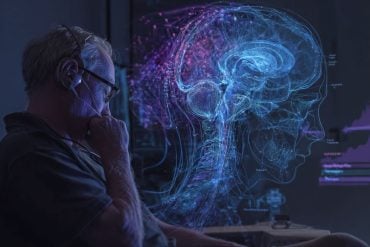Summary: Individuals who have rebounded from a major depressive episode display a distinctive cognitive pattern, processing negative information more extensively and positive information less so than those without a history of depression.
Drawing from a meta-analysis of 44 studies encompassing over 4,000 participants, the study unveiled that while healthy participants swiftly responded to both emotional and non-emotional stimuli, their counterparts with a past tryst with depression had a pronounced tilt towards negative stimuli.
This pattern not only signifies a decreased control over the kind of information processed but also hints at an inherent bias leaning towards negativity.
Key Facts:
- Over 50% of individuals with a first-time major depressive episode will experience subsequent episodes, often relapsing within two years of recovery.
- The study’s meta-analysis included 44 studies, with 2081 participants with a history of major depressive disorder and 2285 healthy controls.
- Those recovered from major depression showed a stronger bias for processing negative information over positive or neutral information compared to controls.
Source: APA
People who have recovered from a major depressive episode, when compared with individuals who have never experienced one, tend to spend more time processing negative information and less time processing positive information, putting them at risk for a relapse.
“Our findings suggest that people who have a history of depression spend more time processing negative information, such as sad faces, than positive information, such as happy faces, and that this difference is greater compared to healthy people with no history,” said lead author Alainna Wen, PhD, a postdoctoral scholar at the Anxiety and Depression Research Center at the University of California, Los Angeles.
“Because more negative thinking and mood and less positive thinking and mood are characteristic of depression, this could mean that these individuals are at a greater risk for having another depressive episode.”
The research was published in the Journal of Psychopathology and Clinical Science.
Major depression is one of the most common mental disorders in the United States. In 2020, approximately 21 million U.S. adults reported at least one incidence of major depression (8.4% of the U.S. population), according to the National Institute of Mental Health.
Defined as a period of at least two weeks of a depressed mood or loss of interest or pleasure in daily activities, major depression can interfere with or limit a person’s ability to carry out major life activities.
Despite well-established treatments for depression, relapse rates for major depressive disorder remain high, according to Wen. More than 50% of individuals with a first-time major depressive episode will experience subsequent episodes, often relapsing within two years of recovery.
Thus, more insight is needed into the risk factors involved in major depressive disorder to improve treatment and prevent relapse.
For this paper, researchers conducted a meta-analysis of 44 studies involving 2081 participants with a history of major depressive disorder and 2285 healthy controls. All studies examined participants’ response times to negative, positive or neutral stimuli. In some cases, participants were shown either a happy, sad or neutral human face and asked to push a different button for each. In others, participants reacted to positive, negative or neutral words.
Healthy participants as a group responded more quickly to emotional and non-emotional stimuli than participants with a history of depression, regardless of whether those stimuli were positive, neutral or negative. But participants who previously had major depressive disorder spent more time processing negative emotional stimuli over positive stimuli compared with controls.
While healthy controls showed a significant difference in how much time they spent processing positive vs. negative emotional stimuli compared with those in remission from major depression, that distinction did not appear when comparing time spent processing negative vs. neutral or positive vs. neutral stimuli.
Overall, the findings suggest that individuals with recurrent major depressive disorder not only are less able to control the information they process than healthy individuals, they also display a greater bias for focusing on negative over positive or neutral information, according to Wen.
“The current findings have implications for the treatment of depression,” said Wen. “Focusing on reducing the processing of negative information alone may not be sufficient to prevent depression relapse. Instead, patients may also benefit from strategies to increase the processing of positive information.”
About this depression and perception research news
Author: APA Public Affairs
Source: APA
Contact: APA Public Affairs – APA
Image: The image is credited to Neuroscience News
Original Research: Open access.
“Biased Cognitive Control of Emotional Information in Remitted Depression: A Meta-Analytic Review” by Alainna Wen et al. Journal of Psychopathology and Clinical Science
Abstract
Biased Cognitive Control of Emotional Information in Remitted Depression: A Meta-Analytic Review
Cognitive theories of depression posit that maladaptive information processing increases the risk for depression recurrence. There is increasing theoretical and empirical support for the cognitive control of emotional information as a vulnerability factor for depression recurrence.
In this investigation, findings from behavioral studies that compared the cognitive control of emotional information between participants with remitted major depressive disorder (rMDD) and healthy control (HC) participants were examined. Response times (RTs) and error rates were used as outcome variables, and aspects of clinical features, sample characteristics, and methodology and design were examined as moderating variables. The final review included 44 articles with a total of 2,081 rMDD participants and 2,285 HC participants.
The two groups significantly differed in the difference score between RTs for negative and positive stimuli. Specifically, the difference in RTs between negative and positive stimuli was larger in participants with rMDD than in HC participants, indicating greater difficulty controlling irrelevant negative (vs. positive) stimuli in rMDD. Such cognitive control bias may be associated with preferential processing of negative over positive information in working memory.
This imbalance may then be linked to other emotional information processing biases and emotion dysregulation, thereby increasing the risk for depression recurrence. Implications, limitations, and future directions are discussed.







